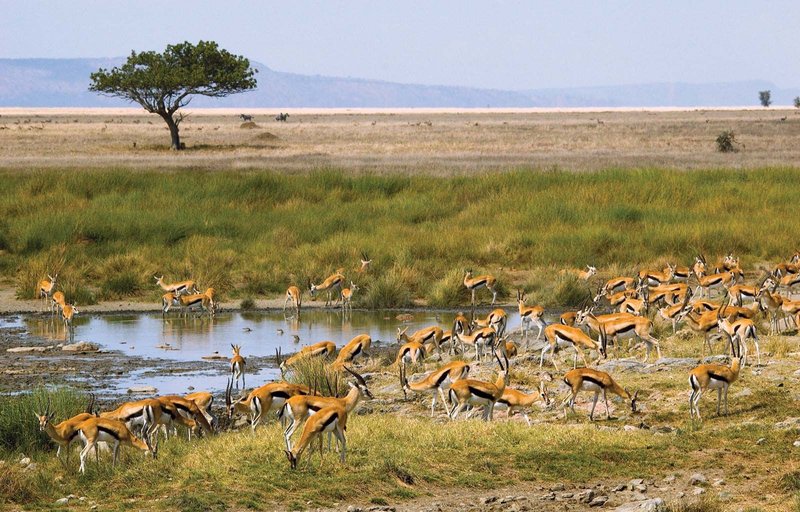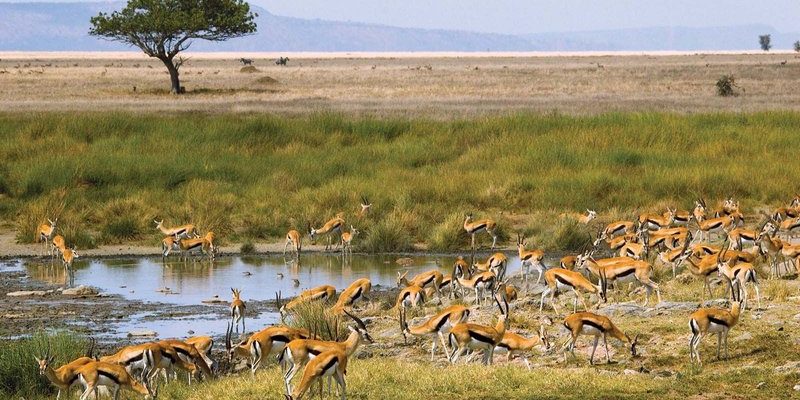
Gazelles are predominantly found in Africa, but their range is more extensive than many people realize. They thrive in various environments, from open grasslands to arid deserts. So, let’s take a closer look at where gazelles live and what makes their habitats special. To guide you through this, we’ll explore different species of gazelles, their preferred environments, and the challenges they face in those areas.
Types of Gazelles and Their Habitats
There are several species of gazelles, each adapted to specific habitats. The most well-known types include the Thompson’s gazelle, Grant’s gazelle, and the Dorcas gazelle. Each species has its own preferred environment, which helps determine where they live.
Thompson’s gazelle, for example, primarily inhabits the savannas and grasslands of East Africa, particularly in Kenya and Tanzania. These areas are known for their rich grasses, which provide ample food. On the other hand, the Grant’s gazelle can be found in similar regions but often prefers slightly more wooded areas, where they can find both cover and food.
Then there’s the Dorcas gazelle, which thrives in arid desert regions, like parts of North Africa and the Arabian Peninsula. These gazelles are well adapted to their harsh environments, surviving with limited water and finding nourishment in sparse vegetation. Each species showcases how gazelles have evolved to survive in their respective niches, demonstrating their incredible adaptability.
The Savanna: An Ideal Home for Gazelles
The savanna is like a buffet for gazelles, offering a variety of grasses and shrubs. This environment provides the food they need, as well as open spaces for quick escapes from predators. The mix of tall and short grasses is vital, allowing gazelles to graze while maintaining a lookout.
Here’s the thing: the savanna isn’t just about food. It’s also about safety. With fewer trees, gazelles can spot potential threats like lions or cheetahs from a distance. This advantage often gives them the upper hand when it comes to survival. When you see a group of gazelles grazing together, you might notice they’re always vigilant—ears perked and eyes scanning the surroundings.
Moreover, savannas often experience seasonal changes. During dry seasons, these areas can become more challenging, as water sources dry up and food becomes scarce. Gazelles have adapted to these shifts by migrating to areas that offer better resources, showcasing their remarkable ability to thrive in dynamic environments.
Desert Life: Gazelles in Arid Regions
You might think life in the desert would be tough for any animal, but gazelles have remarkable adaptations that allow them to survive. The Dorcas gazelle, for instance, is a master of the desert. These creatures can go for long periods without drinking water, extracting moisture from the plants they eat and even from dew.
In their arid habitats, temperatures can soar during the day, making it essential for gazelles to be active during cooler parts. They often graze early in the morning or late in the afternoon when the sun is less intense. This behavior not only helps them conserve energy but also reduces their risk of overheating.
Moreover, the sandy and rocky terrain of deserts offers limited cover, so gazelles rely on their speed and agility to escape predators. With their light builds and long legs, they can reach impressive speeds, making them one of the fastest animals in their habitats. It’s a constant balancing act of finding food while dodging threats.
The Role of Gazelles in Their Ecosystems
Gazelles play a vital role in their ecosystems, much like actors in a grand theatre. Their grazing helps control plant growth, which can prevent overgrowth and maintain balance in their habitats. This balance is crucial because it ensures various species can thrive alongside them—not just plants, but other animals that depend on a healthy ecosystem.
Furthermore, gazelles also serve as prey for many larger predators. By providing a food source for lions, cheetahs, and wild dogs, they help maintain the predator-prey dynamics essential for a healthy ecosystem. When gazelle populations fluctuate, it can impact the entire food chain, showing how interconnected life truly is.
However, the challenges facing gazelles are increasing. Habitat loss due to human development, hunting, and climate change threatens their populations. It’s important for us to understand these issues and advocate for conservation efforts that protect not only gazelles but their entire ecosystems.
Human Impact and Conservation Efforts
The relationship between gazelles and humans has changed dramatically over the years. As populations grow and land is developed for agriculture or urban areas, gazelles face increasing pressures. Their habitats shrink, forcing them into smaller spaces and making it harder to find food and safety.
Conservation efforts play a crucial role in safeguarding these animals. Protected national parks and reserves help maintain habitats where gazelles can flourish. For instance, the Maasai Mara in Kenya and the Serengeti in Tanzania are essential regions for many gazelle populations, providing safe spaces for them to live and reproduce.
However, conservation isn’t just about setting aside land. It involves educating local communities, promoting sustainable practices, and developing policies that balance human needs with wildlife preservation. Understanding where gazelles live helps us appreciate their role in the ecosystem and inspires action for their protection.
In summary, gazelles inhabit a variety of environments, from the lush savannas of East Africa to the stark deserts of North Africa. Each species is uniquely adapted to its habitat, showcasing nature’s incredible ability to thrive amidst challenges. As we learn more about where gazelles live and how they fit into the ecosystem, we can better appreciate their significance to the world around us.
Protecting their habitats and supporting conservation efforts is essential for ensuring that future generations can witness the grace and beauty of these amazing creatures. So, the next time you think of a gazelle, remember it’s not just an animal roaming the plains; it’s a vital part of our planet’s health and diversity. Let’s do our part to help them thrive!

